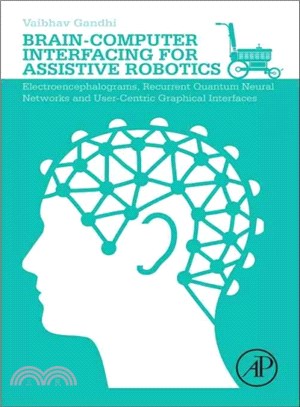Brain-computer interfacing for assistive roboticselectroencephalograms, recurrent quantum neural networks, and user-centric graphical interfaces /
正題名/作者 : Brain-computer interfacing for assistive robotics/ Vaibhav Gandhi.
其他題名 : electroencephalograms, recurrent quantum neural networks, and user-centric graphical interfaces /
作者 : Gandhi, Vaibhav.
出版者 : London, England :Academic Press,2015.
面頁冊數 : 1 online resource.
標題 : Brain-computer interfaces. -
電子資源 : 線上閱讀(Elsevier)
ISBN : 9780128015872$q(electronic bk.)
ISBN : 012801587X$q(electronic bk.)
ISBN : 9780128015438$q(print)
ISBN : 0128015438$q(print)
LEADER 03407cmm 2200241 a 450
001 305379
008 141008s2015 enka ob 001 0 eng d
020 $a9780128015872$q(electronic bk.)
020 $a012801587X$q(electronic bk.)
020 $a9780128015438$q(print)
020 $a0128015438$q(print)
035 $a00357718
041 0 $aeng
050 4$aQP360.7$b.G363 2015eb
082 04$a003.5$223
090 $aE-BOOK/003.5///UE040004
100 1 $aGandhi, Vaibhav.$3548277
245 10$aBrain-computer interfacing for assistive robotics$h[electronic resource] :$belectroencephalograms, recurrent quantum neural networks, and user-centric graphical interfaces /$cVaibhav Gandhi.
260 $aLondon, England :$bAcademic Press,$c2015.
300 $a1 online resource.
504 $aIncludes bibliographical references and index.
505 0 $a1. Introduction -- 1.1. Introduction -- 1.2. Rationale -- 1.3. Objectives -- 2. Interfacing Brain and Machine -- 2.1. Introduction -- 2.2. The Brain and Electrode Placement -- 2.3. Operational Techniques in BCI -- 2.4. Data Acquisition -- 2.5. Preprocessing: A Signal Enhancement Requirement Along with Noise Reduction -- 2.6. Feature Extraction -- 2.7. Classification -- 2.8. Post-processing -- 2.9. Validation and Optimization Techniques -- 2.10. Graphical User Interface [GUI] -- 2.11. Strategies in BCI Applications -- 2.12. Performance Measures of a BCI System -- 2.13. Conclusion -- 3. Fundamentals of Recurrent Quantum Neural Networks -- 3.1. Introduction -- 3.2. Postulates of Quantum Mechanics -- 3.3. Quantum Mechanics and the Schrodinger Wave Equation -- 3.4. Theoretical Concept of the RQNN Model -- 3.5. Traditional RQNN-Based Signal Enhancement -- 3.6. Revised RQNN-Based Signal Enhancement -- 3.7. Discussion -- 3.8. Conclusion.
505 8 $a4. The Proposed Graphical User Interface (GUI) -- 4.1. Introduction -- 4.2. Overview of the Proposed GUI Within the BCI Framework -- 4.3. Interfacing MATLAB and Visual Basic -- 4.4. Conclusion -- 5. Recurrent Quantum Neural Network (RQNN)- Based EEG Enhancement -- 5.1. Introduction -- 5.2. Traditional RQNN Model for EEG Enhancement -- 5.3. Revised RQNN Model for EEG Signal Enhancement -- 5.4. Towards Subject-Specific RQNN Parameters -- 5.5. Discussion -- 5.6. Conclusion -- 6. Graphical User Interface (GUI) and Robot Operation -- 6.1. Introduction -- 6.2. The EEG Acquisition Process -- 6.3. RQNN-Based EEG Signal Enhancement -- 6.4. Autonomous and Supervised GUI Operation -- 6.5. Maneuvering the Simulated Mobile Robot Using Only MI EEG -- 6.6. Maneuvering the Physical Mobile Robot Using Only MI EEG -- 6.7. Conclusion -- 7. Conclusion -- 7.1. Contributions of the Book -- 7.2. Future Research Directions -- 7.3. Conclusion.
520 $aBrain-computer interface (BCI) technology provides a means of communication that allows individuals with severely impaired movement to communicate with assistive devices using the electroencephalogram (EEG) or other brain signals. The practicality of a BCI has been possible due to advances in multi-disciplinary areas of research related to cognitive neuroscience, brain-imaging techniques and human-computer interfaces. However, two major challenges remain in making BCI for assistive robotics practical for day-to-day use: the inherent lower bandwidth of BCI, and how to best handle the unknown e.
650 0$aBrain-computer interfaces.$3417668
650 0$aRobotics in medicine.$3349907
650 0$aElectroencephalography.$3414432
650 2$aBrain-Computer Interfaces.$3476220
655 4$aElectronic books.$3297295
856 40$uhttps://erm.library.ntpu.edu.tw/login?url=https://www.sciencedirect.com/science/book/9780128015438$z線上閱讀(Elsevier)
Brain-computer interfacing for assistive roboticselectroencephalograms, recurrent quantum neural networks, and user-centric graphical interfaces /[electronic resource] :Vaibhav Gandhi. - London, England :Academic Press,2015. - 1 online resource.
Includes bibliographical references and index.
1. Introduction -- 1.1. Introduction -- 1.2. Rationale -- 1.3. Objectives -- 2. Interfacing Brain and Machine -- 2.1. Introduction -- 2.2. The Brain and Electrode Placement -- 2.3. Operational Techniques in BCI -- 2.4. Data Acquisition -- 2.5. Preprocessing: A Signal Enhancement Requirement Along with Noise Reduction -- 2.6. Feature Extraction -- 2.7. Classification -- 2.8. Post-processing -- 2.9. Validation and Optimization Techniques -- 2.10. Graphical User Interface [GUI] -- 2.11. Strategies in BCI Applications -- 2.12. Performance Measures of a BCI System -- 2.13. Conclusion -- 3. Fundamentals of Recurrent Quantum Neural Networks -- 3.1. Introduction -- 3.2. Postulates of Quantum Mechanics -- 3.3. Quantum Mechanics and the Schrodinger Wave Equation -- 3.4. Theoretical Concept of the RQNN Model -- 3.5. Traditional RQNN-Based Signal Enhancement -- 3.6. Revised RQNN-Based Signal Enhancement -- 3.7. Discussion -- 3.8. Conclusion.
Brain-computer interface (BCI) technology provides a means of communication that allows individuals with severely impaired movement to communicate with assistive devices using the electroencephalogram (EEG) or other brain signals. The practicality of a BCI has been possible due to advances in multi-disciplinary areas of research related to cognitive neuroscience, brain-imaging techniques and human-computer interfaces. However, two major challenges remain in making BCI for assistive robotics practical for day-to-day use: the inherent lower bandwidth of BCI, and how to best handle the unknown e.
ISBN: 9780128015872$q(electronic bk.)Subjects--Topical Terms:
417668
Brain-computer interfaces.
Index Terms--Genre/Form:
297295
Electronic books.
LC Class. No.: QP360.7 / .G363 2015eb
Dewey Class. No.: 003.5
- 館藏(1)
- 心得(0)
- 標籤
- 相同喜好的讀者(0)
- 相關資料(0)

